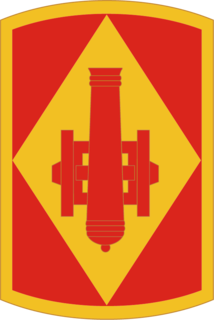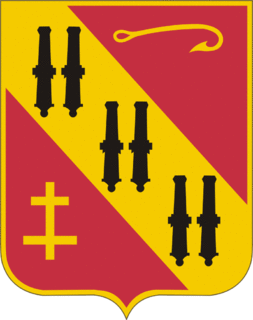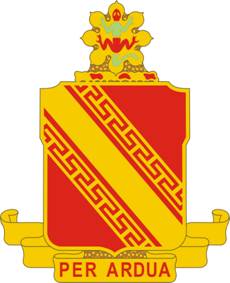56th Artillery
In April 1963, the 56th Artillery Group was activated in Schwäbisch Gmünd, West Germany commanded by Col. Douglas C. France, Jr. The group prepared for the deployment of the new weapons system, the Pershing 1 nuclear missile. Headquarters & Headquarters Battery (HHB) was initially stationed at Hardt Kaserne (formerly Adolf Hitler Kaserne) and moved to Bismarck Kaserne in November 1968.
The 56th Artillery Group was redesignated as the 56th Artillery Brigade on 17 August 1970. The brigade was authorized an increased level in command positions in the firing units. Platoon leaders were captains, battery commanders were majors, battalion commanders were lieutenant colonels and the brigade commander was a colonel.
With the split of the Artillery Branch into Field Artillery and Air Defense Artillery, the brigade was redesignated as the 56th Field Artillery Brigade on 15 March 1972.
In 1965 the 56th Artillery Group assumed the critical role of a Quick Reaction Alert (QRA) force and was required to maintain a portion of each unit at the highest level of combat readiness. These portions were to react within seconds of verified orders, and the entire command was to be fully operational within 2 hours of any alert activation. The increased requirements of the QRA mission necessitated some modifications to upgrade the Pershing missile system and at the same time caused the Army to increase the number of launchers at each battalion from four to 36.
The newly designated brigade was to command 1st Battalion, 41st Field Artillery Regiment, 1st Battalion, 81st Field Artillery Regiment, and 3rd Battalion, 84th Field Artillery Regiment as Pershing firing battalions. Also subordinate to the brigade was 2nd Battalion, 4th Infantry Regiment, tasked to provide defensive support to the firing units according to their security needs. A host of additional units provided support from medical to logistical, ensuring the brigade's ability to operate.
In November 1983, with the Soviets fully invested in the SS-20, and on the verge of bankruptcy, the Americans began fielding the Pershing II. By 1985 all three firing battalions were completely operational with Pershing II and the Soviet Union faced a threat they were financially unwilling to counter. [18]
On 11 January 1985 three soldiers, SSG John Leach, SGT Todd A. Zephier, and PFC Darryl L. Shirley of Battery C, 3rd Battalion, 84th Field Artillery were killed in an explosion at Camp Redleg, Heilbronn. The explosion occurred while removing a missile stage from the storage container during an assembly operation. An investigation revealed that the Kevlar rocket bottle had accumulated a triboelectric charge in the cold dry weather; as the engine was removed from the container the electrical charge began to flow and created a hot spot that ignited the propellant. [19] [20] A moratorium on missile movement was enacted through late 1986 when new grounding and handling procedures were put into place.
In January 1986, there was a major reorganization; the 56th Field Artillery Brigade was redesignated the 56th Field Artillery Command and authorized a major general as its commander. 1st Battalion, 81st Field Artillery inactivated and reformed as 1st Battalion, 9th Field Artillery in Neu-Ulm. 1st Battalion, 41st Field Artillery inactivated and reformed as 2nd Battalion, 9th Field Artillery in Schwäbisch-Gmünd. 3rd Battalion, 84th Field Artillery inactivated and reformed as 4th Battalion, 9th Field Artillery in Heilbronn. Along with 3rd Battalion, 9th Field Artillery at Fort Sill, the four firing units were then under the 9th Field Artillery Regiment. Additionally, the 55th Maintenance Battalion redesignated as 55th Support Battalion, E Company, 55th Maintenance Battalion deactivated and reformed as the 193rd Aviation Company, [21] and the communications assets at each battery, were removed and consolidated into the 38th Signal Battalion.
Under the reorganization, the 56th Field Artillery Command would always report directly to the highest commander in Europe at the time. Therefore, during peacetime, they reported to the Commander in Chief of United States Army Europe (CINCUSAREUR), whereas, during heightened tension or war, command passed to NATO, with Allied Air Forces Central Europe as their next higher headquarters. [22]
Additionally, command levels for the field artillery batteries were increased by one grade over similar units. Platoons were commanded by a captain, and batteries by a major. Battalions continued to follow a lieutenant colonel while the command itself was led by a brigadier general and later a major general.
These actions were meant to mitigate the increased responsibilities inherent with the mission they bore.
The Intermediate-Range Nuclear Forces Treaty [23] was ratified on 27 May 1988. [24] The firing batteries began to draw down their equipment as the missile launchers were destroyed. The Pershing first- and second-stage motors, reentry vehicles, warhead and radar section airframes were returned to Pueblo Depot Activity for elimination. On 30 June 1991, the 56th FA was inactivated, [25] and "discontinued" on 30 September 1991. [26]























